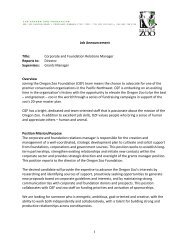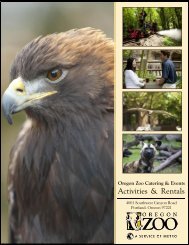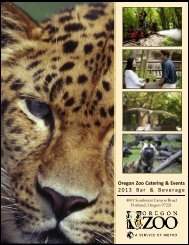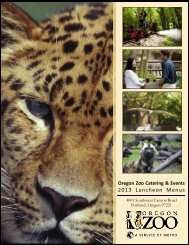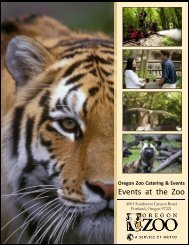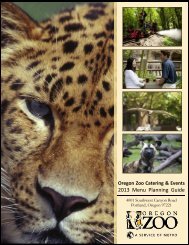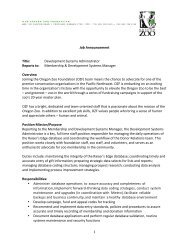Oregon Zoo Elephant Birth Expected in Late 2012
Oregon Zoo Elephant Birth Expected in Late 2012
Oregon Zoo Elephant Birth Expected in Late 2012
Create successful ePaper yourself
Turn your PDF publications into a flip-book with our unique Google optimized e-Paper software.
Pachyderm<br />
Pend<strong>in</strong>g<br />
<strong>Oregon</strong> <strong>Zoo</strong> <strong>Elephant</strong> <strong>Birth</strong><br />
<strong>Expected</strong> <strong>in</strong> <strong>Late</strong> <strong>2012</strong><br />
Information & Resource KiT<br />
For more <strong>in</strong>formation, contact:<br />
Hova Najarian at 503-220-5714 or hova.najarian@oregonzoo.org<br />
Ian Gill<strong>in</strong>gham at 503-220-2448 or ian.gill<strong>in</strong>gham@oregonzoo.org
<strong>in</strong>side<br />
A new elephant baby, a better elephant home . . . . . 3<br />
50 years of elephant births . . . . . . . . . . . . . . . . . . . . 4<br />
<strong>Elephant</strong> babies . . . . . . . . . . . . . . . . . . . . . . . . . . . . 6<br />
<strong>Zoo</strong> family . . . . . . . . . . . . . . . . . . . . . . . . . . . . . . . . 7<br />
Gett<strong>in</strong>g to know Rose-Tu . . . . . . . . . . . . . . . . . . . . . 8<br />
Gett<strong>in</strong>g to know Samudra . . . . . . . . . . . . . . . . . . . 10<br />
Gett<strong>in</strong>g to know the zoo elephants . . . . . . . . . . . . 11<br />
<strong>Elephant</strong> Lands: The new elephant habitat . . . . . . . 13<br />
Conservation <strong>in</strong> North America . . . . . . . . . . . . . . . 15<br />
Conservation <strong>in</strong> range countries . . . . . . . . . . . . . . . 16<br />
Asian elephant fact sheet . . . . . . . . . . . . . . . . . . . . 17<br />
See more . . . . . . . . . . . . . . . . . . . . . . . . . . . . . . . . 18<br />
Contact<br />
For more <strong>in</strong>formation or to schedule an <strong>in</strong>terview<br />
with <strong>Oregon</strong> <strong>Zoo</strong> staff, please contact:<br />
Hova Najarian<br />
Media and Public Relations Officer<br />
503-220-5714<br />
hova.najarian@oregonzoo.org<br />
Ian Gill<strong>in</strong>gham<br />
Assistant Media and Public Relations Officer<br />
503-220-2448<br />
ian.gill<strong>in</strong>gham@oregonzoo.org<br />
About the <strong>Oregon</strong> <strong>Zoo</strong><br />
The zoo is a service of Metro and is dedicated to its<br />
mission of <strong>in</strong>spir<strong>in</strong>g the community to create a better<br />
future for wildlife. Committed to conservation, the<br />
zoo is currently work<strong>in</strong>g to save endangered California<br />
condors, <strong>Oregon</strong> silverspot and Taylor’s checkerspot<br />
butterflies, western pond turtles, <strong>Oregon</strong> spotted frogs<br />
and K<strong>in</strong>caid’s lup<strong>in</strong>e. Other projects <strong>in</strong>clude studies on<br />
black rh<strong>in</strong>os, Asian elephants, polar bears and bats.<br />
The zoo relies <strong>in</strong> part on community support through<br />
donations to the <strong>Oregon</strong> <strong>Zoo</strong> Foundation to undertake<br />
these and many other animal welfare, education and<br />
susta<strong>in</strong>ability programs. For hours and rates, visit www.<br />
oregonzoo.org or call 503-226-1561.<br />
O R E G O N Z O O P A C h y d e r m P E N D I N G 2 0 1 2 M E D I A K I T<br />
2
A New <strong>Elephant</strong> Baby A Better <strong>Elephant</strong> Home<br />
As Asian elephant Rose-Tu approaches her due<br />
date, <strong>Oregon</strong> <strong>Zoo</strong> keepers are busy prepar<strong>in</strong>g<br />
for the new calf’s arrival — as well as excit<strong>in</strong>g<br />
improvements to the elephants’ home habitat. Learn<br />
more <strong>in</strong> this resource packet about the <strong>Oregon</strong> <strong>Zoo</strong>’s<br />
elephant herd, their new roam<strong>in</strong>g grounds, the zoo’s<br />
central role <strong>in</strong> species survival and more.<br />
Rose-Tu, an 18-year-old Asian<br />
elephant, is expected to give birth<br />
<strong>in</strong> late autumn <strong>2012</strong>. She became<br />
pregnant <strong>in</strong> late February 2011<br />
by Tusko, the 40-year-old bull<br />
who also sired Rose-Tu’s first calf,<br />
Samudra. When Samudra was born <strong>in</strong> 2008, he was<br />
the first third-generation elephant born <strong>in</strong> the United<br />
States.<br />
LEARN MORE:<br />
• Rose-Tu – page 8<br />
• Samudra – page 10<br />
The elephants at the zoo live <strong>in</strong><br />
a matriarchal herd, as elephants<br />
do <strong>in</strong> the wild. The <strong>Oregon</strong> <strong>Zoo</strong><br />
is poised to beg<strong>in</strong> construction<br />
<strong>in</strong> 2013 on <strong>Elephant</strong> Lands, a<br />
visionary expansion of the elephant habitat that will<br />
quadruple the elephants’ space and dramatically<br />
enhance their experiences and daily rout<strong>in</strong>es.<br />
LEARN MORE:<br />
• <strong>Zoo</strong> elephant herd – page 11<br />
• Habitat improvements – page 13<br />
• Fast facts about elephants – page 17<br />
The <strong>Oregon</strong> <strong>Zoo</strong> is recognized worldwide<br />
for its successful breed<strong>in</strong>g program for<br />
Asian elephants, which has now spanned<br />
five decades. More than 25 elephants<br />
have been born at the zoo, beg<strong>in</strong>n<strong>in</strong>g with<br />
Packy <strong>in</strong> 1962. Samudra is the first thirdgeneration<br />
elephant to be born <strong>in</strong> the United States.<br />
LEARN MORE:<br />
• 50 years of <strong>Oregon</strong> <strong>Zoo</strong> elephant births – page 4<br />
• <strong>Elephant</strong> babies – page 6<br />
The <strong>Oregon</strong> <strong>Zoo</strong>’s central role <strong>in</strong> the<br />
Association of <strong>Zoo</strong>s and Aquariums’<br />
Species Survival Plan for Asian elephants<br />
has earned an <strong>in</strong>ternational reputation<br />
for its research and commitment to<br />
help<strong>in</strong>g this endangered species. Asian elephants are<br />
considered highly endangered <strong>in</strong> their range countries,<br />
threatened by habitat loss and conflict with humans. The<br />
<strong>Oregon</strong> <strong>Zoo</strong> provides support for <strong>in</strong>ternational programs<br />
to help elephants survive <strong>in</strong> the wild.<br />
LEARN MORE:<br />
• Conservation <strong>in</strong> North America – page 15<br />
• Conservation <strong>in</strong> range countries – page 16<br />
O R E G O N Z O O P A C h y d e r m P E N D I N G 2 0 1 2 M E D I A K I T<br />
3
50 years of elephant <strong>Birth</strong>s at the <strong>Oregon</strong> zoo<br />
If there were an elephant capital of North America,<br />
it would likely be located at the <strong>Oregon</strong> <strong>Zoo</strong>. The<br />
zoo has been a pioneer <strong>in</strong> elephant breed<strong>in</strong>g for<br />
more than five decades, and much of its history is<br />
<strong>in</strong>timately <strong>in</strong>tertw<strong>in</strong>ed with elephants. Many important<br />
zoo milestones <strong>in</strong>volve these gentle yet giant creatures,<br />
which have <strong>in</strong>spired generations of visitors while<br />
help<strong>in</strong>g scientists and researchers make important<br />
breakthroughs — discoveries that have helped us better<br />
understand and protect elephants around the world.<br />
In the beg<strong>in</strong>n<strong>in</strong>g<br />
The story starts with an elephant named Rosy, who<br />
arrived <strong>in</strong> Portland from Thailand <strong>in</strong> 1953. Rosy sparked<br />
public excitement for a zoo that was then largely<br />
outdated and overlooked, and follow<strong>in</strong>g her arrival,<br />
voters passed a special levy to f<strong>in</strong>ance construction of a<br />
new, modern facility at the current zoo’s location — a<br />
levy that voters had<br />
rejected just a<br />
few years before.<br />
Packy<br />
The zoo opened at<br />
its new location <strong>in</strong><br />
1959. Only three<br />
years later, the zoo<br />
made history when<br />
Packy was born on April 14, 1962. Packy was the first<br />
elephant to have been born <strong>in</strong> the Western Hemisphere<br />
<strong>in</strong> 44 years. At the time, only n<strong>in</strong>e other elephants<br />
had been born <strong>in</strong> North America. The event earned<br />
<strong>in</strong>ternational attention and drew more than a million<br />
visitors to the zoo for the first time. Life magaz<strong>in</strong>e<br />
covered the momentous occasion with a lengthy feature<br />
describ<strong>in</strong>g the “nativity of Packy.”<br />
elephant habitats, was a chief architect of the plan,<br />
which coord<strong>in</strong>ates breed<strong>in</strong>g efforts among AZA-member<br />
organizations across the country.<br />
Groundbreak<strong>in</strong>g discoveries<br />
While its breed<strong>in</strong>g efforts have earned it an <strong>in</strong>ternational<br />
reputation, the zoo has also encouraged and actively<br />
participated <strong>in</strong> groundbreak<strong>in</strong>g elephant research.<br />
Discoveries made here have profoundly improved our<br />
ability to understand and protect these endangered<br />
animals. In the 1970s, researchers at the zoo learned<br />
how to determ<strong>in</strong>e the estrous cycle of female elephants,<br />
one of the most important keys to understand<strong>in</strong>g<br />
elephant breed<strong>in</strong>g. And, while observ<strong>in</strong>g the zoo’s<br />
elephant herd <strong>in</strong> 1984, scientist Kather<strong>in</strong>e B. Payne<br />
discovered that elephants use <strong>in</strong>frasonic communication,<br />
produc<strong>in</strong>g sounds outside the range of human hear<strong>in</strong>g.<br />
Currently, the <strong>Oregon</strong> <strong>Zoo</strong> is partner<strong>in</strong>g with several<br />
North American zoos and universities to conduct a new<br />
study of elephant welfare, one of the first major research<br />
projects to look at positive <strong>in</strong>dicators of elephants’<br />
wellbe<strong>in</strong>g — <strong>in</strong> essence, signs that an elephant is<br />
mentally and physically fit. The zoo also cont<strong>in</strong>ues<br />
to track progesterone levels <strong>in</strong> its female elephants<br />
to better understand elephant reproduction. The<br />
progesterone <strong>in</strong>formation collected at the zoo is now the<br />
largest longterm data set about elephant estrous cycles<br />
<strong>in</strong> the world.<br />
Leader <strong>in</strong> elephant welfare<br />
In addition to such research, the <strong>Oregon</strong> <strong>Zoo</strong> has played<br />
an important role <strong>in</strong> implement<strong>in</strong>g the highest possible<br />
standards of care and management for elephants.<br />
Breed<strong>in</strong>g for survival<br />
Packy’s birth kicked off a baby boom among <strong>Oregon</strong><br />
<strong>Zoo</strong> elephants. Not half a year later, Rosy, the zoo’s<br />
orig<strong>in</strong>al elephant, gave birth to Me-Tu. Over the next<br />
four decades, more elephants were born here than at<br />
any other zoo <strong>in</strong> North America. When the Association<br />
of <strong>Zoo</strong>s and Aquariums created its Species Survival<br />
Plan for elephants <strong>in</strong> 1985, the <strong>Oregon</strong> <strong>Zoo</strong> played<br />
a central role. Mike Keele, now the zoo’s director of<br />
O R E G O N Z O O P A C h y d e r m P E N D I N G 2 0 1 2 M E D I A K I T<br />
4
50 years of elephant <strong>Birth</strong>s at the <strong>Oregon</strong> zoo<br />
Through its AZA affiliation, the zoo has hosted a variety<br />
of conferences and events — like the first and second<br />
North American Conferences on <strong>Elephant</strong> Foot Care and<br />
Pathology and the fifth International <strong>Elephant</strong> Research<br />
Symposium — that gather elephant experts from across<br />
the country and around the globe. The zoo participates<br />
<strong>in</strong> these events to ensure our herd benefits from the<br />
most current management practices regard<strong>in</strong>g diet,<br />
exercise, enrichment and health care.<br />
A new home for a grow<strong>in</strong>g family<br />
When bull elephant Tusko jo<strong>in</strong>ed the herd <strong>in</strong> 2005, the<br />
zoo aga<strong>in</strong> began breed<strong>in</strong>g among its elephants, add<strong>in</strong>g<br />
a new chapter to an already rich history. The <strong>Oregon</strong> <strong>Zoo</strong><br />
is now home to three cows, three bulls and one young<br />
male. Five members of this tightly knit family were born<br />
at the <strong>Oregon</strong> <strong>Zoo</strong>, and Rose-Tu has another calf on the<br />
way. Due <strong>in</strong> late fall of <strong>2012</strong>, the new baby isn’t the only<br />
excit<strong>in</strong>g th<strong>in</strong>g <strong>in</strong> store for the elephants:<br />
Designs for the <strong>Elephant</strong> Lands, the zoo’s new elephant<br />
habitat, are under way, with construction scheduled to<br />
beg<strong>in</strong> <strong>in</strong> 2013. The herd’s new home (see page 13) will<br />
<strong>in</strong>clude a variety of habitats and terra<strong>in</strong> and will offer<br />
more opportunities for the elephants to make choices<br />
about how and where they spend their time — <strong>in</strong>side or<br />
outside, <strong>in</strong> a group or away from the herd, play<strong>in</strong>g <strong>in</strong> the<br />
water or walk<strong>in</strong>g through the grass.<br />
O R E G O N Z O O P A C h y d e r m P E N D I N G 2 0 1 2 M E D I A K I T<br />
5
<strong>Elephant</strong> Babies<br />
Sometime <strong>in</strong> late <strong>2012</strong>, Rose-Tu will give birth to her<br />
second baby elephant. Rose-Tu’s first calf, Samudra,<br />
was born at the <strong>Oregon</strong> <strong>Zoo</strong> <strong>in</strong> August 2008.<br />
If “late <strong>2012</strong>” seems imprecise, bear <strong>in</strong> m<strong>in</strong>d that an<br />
elephant’s gestation lasts 20 to 22 months. (See<br />
illustration.) Rose-Tu was probably impregnated by Tusko<br />
dur<strong>in</strong>g the third week of February 2011, so the new<br />
baby is expected anytime from late October to late<br />
December <strong>2012</strong>.<br />
Successfully br<strong>in</strong>g<strong>in</strong>g a baby elephant <strong>in</strong>to the herd takes<br />
a tremendous, coord<strong>in</strong>ated effort between zookeepers,<br />
the mother-to-be and the other female elephants, which<br />
serve as the baby’s “aunties.”<br />
<strong>Elephant</strong> keepers and veter<strong>in</strong>arians are prepar<strong>in</strong>g for<br />
Rose-Tu’s birth by keep<strong>in</strong>g her active — both physically<br />
and mentally. Through daily exercise, a pregnant<br />
elephant can stay toned and healthy, which helps<br />
m<strong>in</strong>imize the difficulty of labor. Dur<strong>in</strong>g Rose-Tu’s<br />
pregnancy, keepers are monitor<strong>in</strong>g her weight closely.<br />
In the blood<br />
Keepers receive much of their <strong>in</strong>formation from<br />
the elephant’s blood. Us<strong>in</strong>g weekly blood tests,<br />
they plot the females’ reproductive cycles so<br />
breed<strong>in</strong>g can be carefully managed. <strong>Elephant</strong>s<br />
cycle about every four months and can conceive<br />
only <strong>in</strong> a short four-day period.<br />
Pregnancy can be confirmed about 16 weeks<br />
after mat<strong>in</strong>g by measur<strong>in</strong>g hormone levels <strong>in</strong> the<br />
blood. If progesterone levels rema<strong>in</strong> elevated for<br />
16 weeks, the elephant is confirmed pregnant. If<br />
the elephant is not pregnant, she beg<strong>in</strong>s<br />
ovulat<strong>in</strong>g aga<strong>in</strong>, which is confirmed by<br />
progesterone levels that drop close to zero.<br />
An <strong>in</strong>fant elephant at birth usually weighs between 180<br />
and 330 pounds with the average at about 220 pounds.<br />
Rose-Tu weighed 180 pounds upon delivery, and<br />
Samudra weighed 286 pounds.<br />
Part of a family<br />
A newborn is an important addition to the herd.<br />
Chendra and Sung-Sur<strong>in</strong> served as “aunties,” help<strong>in</strong>g to<br />
look after him. Initially, the father, Tusko, will not <strong>in</strong>teract<br />
with the baby. Eventually, he will be <strong>in</strong>troduced as the<br />
calf cont<strong>in</strong>ues to <strong>in</strong>teract with the rest of the herd.<br />
Nurs<strong>in</strong>g is an important part of an <strong>in</strong>fant’s growth and<br />
development. After an expected <strong>in</strong>itial weight loss <strong>in</strong> the<br />
first week, calves should ga<strong>in</strong> about 2 pounds per day. A<br />
baby elephant can nurse for up to five years, and will<br />
beg<strong>in</strong> supplement<strong>in</strong>g its mother’s milk with solid food<br />
after 10 or 12 months. A calf learns to eat solid foods by<br />
imitat<strong>in</strong>g other elephants as he gets older.<br />
Wait<strong>in</strong>g for Baby<br />
Pygmy Rabbit: 25 days<br />
Gorilla: 257 days<br />
Caracal: 70-78 days<br />
Blue whale: 360 days<br />
Gestation<br />
Period<br />
4 months<br />
Br<strong>in</strong>g<strong>in</strong>g up baby<br />
When a baby is born, the mother’s <strong>in</strong>st<strong>in</strong>cts<br />
should respond immediately. She may try to help<br />
the calf to its feet (with her trunk or foot). It’s<br />
uncommon, but not unheard of, for elephants to<br />
actually lift the calf to its feet. In the wild, there is<br />
a constant threat from predators. A calf that<br />
doesn’t get to its feet quickly is at risk of be<strong>in</strong>g<br />
attacked by a predator.<br />
Giraffe: 420-468 days<br />
Asian elephant: 640-660 days<br />
SOURCES: Restor<strong>in</strong>g the Pacific Northwest; Explor<strong>in</strong>g<br />
Mammals, Int’l Wildlife Encyclopedia; A Companion to<br />
Biological Anthropology; Mammalogy; Biology,<br />
Medic<strong>in</strong>e, and Surgery of <strong>Elephant</strong>s<br />
S. Hess / ©<strong>Oregon</strong> <strong>Zoo</strong><br />
O R E G O N Z O O P A C h y d e r m P E N D I N G 2 0 1 2 M E D I A K I T<br />
6
zoo family<br />
The new elephant baby’s ties to other <strong>Oregon</strong> <strong>Zoo</strong><br />
elephants will run deep. In fact, the calf will jo<strong>in</strong><br />
Samudra as the only third-generation elephant<br />
births <strong>in</strong> the U.S.A. Explore the family tree to see how<br />
this tightly bonded group has grown over time.<br />
<strong>Elephant</strong>s are matriarchal, so the herd’s two ma<strong>in</strong><br />
genealogical l<strong>in</strong>es are <strong>in</strong>dicated by their female founders,<br />
Belle and Rosy.<br />
PET<br />
SUNG-SURIN (SHINE)<br />
BELLE<br />
PACKY<br />
RAMA<br />
THONGLAW<br />
ROSY<br />
TUSKO<br />
SAMUDRA<br />
HUGO<br />
ME-TU<br />
ROSE-TU<br />
Sam’s new sibl<strong>in</strong>g is<br />
due late fall <strong>2012</strong>.<br />
CHENDRA jo<strong>in</strong>ed the herd <strong>in</strong> 1999 after she was<br />
orphaned <strong>in</strong> Borneo; she is Sam’s favorite “auntie.”<br />
— the <strong>Oregon</strong> <strong>Zoo</strong> elephant herd<br />
Hugo photo by Benjam<strong>in</strong> Br<strong>in</strong>k, courtesy of The <strong>Oregon</strong>ian.<br />
O R E G O N Z O O P A C h y d e r m P E N D I N G 2 0 1 2 M E D I A K I T<br />
7
gett<strong>in</strong>g to know Rose-tu<br />
Playful and highly <strong>in</strong>telligent, Rose-Tu is one of the<br />
most popular elephants <strong>in</strong> the herd. Born at the<br />
<strong>Oregon</strong> <strong>Zoo</strong> <strong>in</strong> 1994 to Me-Tu and Hugo, she was<br />
considered by keepers as one of the feistiest babies the<br />
herd had produced <strong>in</strong> years — a trait she seems to have<br />
passed on to her first calf, Samudra (see page 10).<br />
Now 18 years old and expect<strong>in</strong>g her second calf <strong>in</strong> late<br />
<strong>2012</strong>, Rose-Tu is still playful but has also matured <strong>in</strong>to<br />
her role as the mother of the zoo’s third generation of<br />
elephant babies.<br />
Her birth<br />
Although zookeepers did not expect Rose-Tu’s delivery<br />
until October of 1994, mother Me-Tu began show<strong>in</strong>g<br />
signs of oncom<strong>in</strong>g labor at the end of August. After a<br />
three-day vigil, however, the baby still had not made its<br />
appearance.<br />
<strong>Zoo</strong>keepers decided to <strong>in</strong>duce labor with an <strong>in</strong>jection of<br />
oxytoc<strong>in</strong>, a drug similar to that used to <strong>in</strong>duce birth <strong>in</strong><br />
humans.<br />
“Once the <strong>in</strong>jection was given, the labor proceeded<br />
quickly,” said Dennis Pate, zoo curator at the time.<br />
“Me-Tu began bend<strong>in</strong>g at her knee, and a large bulge<br />
appeared below her tail.”<br />
N<strong>in</strong>eteen m<strong>in</strong>utes later, on Aug. 31, the 180-pound calf<br />
was born. She was the 26th elephant born at the zoo.<br />
The baby made attempts to stand almost immediately.<br />
After several failed attempts, she made it to her feet and<br />
stood for 21 m<strong>in</strong>utes. She was nurs<strong>in</strong>g with<strong>in</strong> an hour<br />
after birth.<br />
<strong>Late</strong>r that even<strong>in</strong>g, Me-Tu unexpectedly gave birth to a<br />
female tw<strong>in</strong>, the first <strong>in</strong>cidence of tw<strong>in</strong> elephant birth <strong>in</strong><br />
North America. The second calf was completely still after<br />
birth, and she died after a two-hour attempt by<br />
veter<strong>in</strong>ary staff to keep her alive. A necropsy revealed<br />
bra<strong>in</strong> damage and a collapsed lung.<br />
The name of the Rose<br />
By October, her orig<strong>in</strong>al due date, more than 100,000<br />
people had visited the rambunctious and spirited calf,<br />
but she still didn’t have a name.<br />
“This 175-pounder has great motor skills and is one of<br />
the most unique calves I’ve seen,” said longtime<br />
elephant keeper Roger Henneous. “She’s blow<strong>in</strong>g<br />
bubbles with her trunk, skipp<strong>in</strong>g and act<strong>in</strong>g very feisty.<br />
All she needs now is a name.”<br />
The zoo received thousands of suggestions from the<br />
public and whittled the choices down to five: Asha,<br />
Koofed, Rose-Tu, Jorda or Song.<br />
After a public vote, the calf was named Rose-Tu <strong>in</strong> honor<br />
of her mother and grandmother, Me-Tu and Rosy.<br />
Her first pregnancy<br />
From 1994 to 2005, the zoo suspended its elephantbreed<strong>in</strong>g<br />
program, unable to risk the 50 percent chance<br />
the calf would be a male. At the time, the zoo lacked<br />
the space to house another bull elephant.<br />
In June of 2005, the zoo received the bull elephant<br />
Tusko on a breed<strong>in</strong>g loan, and he and Rose-Tu were <strong>in</strong>troduced<br />
<strong>in</strong> the fall of 2006. Rose-Tu got along well with<br />
O R E G O N Z O O P A C h y d e r m P E N D I N G 2 0 1 2 M E D I A K I T 8
In the third week of February 2011, Rose-Tu became<br />
pregnant for the second time by Tusko. Given Asian elephants’<br />
20- to 22-month gestation range, her new calf<br />
is expected <strong>in</strong> November or December <strong>2012</strong>.<br />
Rose-Tu has stayed <strong>in</strong> good health and will keep an active<br />
schedule right to the day of birth. Keepers are helpgett<strong>in</strong>g<br />
to know Rose-tu<br />
Tusko and was receptive to his advances, and later that<br />
year she became pregnant with her first calf.<br />
After a nearly two-year gestation and 33 hours of labor,<br />
Rose-Tu gave birth to 286-pound Samudra on August<br />
23, 2008. But hav<strong>in</strong>g never seen a birth before, the firsttime<br />
mom nearly trampled her baby. Keepers quickly<br />
<strong>in</strong>tervened, and zoo staff worked around the clock for a<br />
week to ensure the mother-calf bond became the strong<br />
one it is today. S<strong>in</strong>ce Rose-Tu has now experienced childbirth,<br />
keepers believe she will understand better what is<br />
happen<strong>in</strong>g dur<strong>in</strong>g her second birth.<br />
Her second pregnancy<br />
<strong>in</strong>g by monitor<strong>in</strong>g Rose-Tu’s weight — at about 7,700<br />
pounds, she’s packed on less than 500 pounds of baby<br />
weight — and lead<strong>in</strong>g her through exercises that will<br />
help her deliver her calf safely. Rose-Tu’s daily workout<br />
rout<strong>in</strong>e <strong>in</strong>cludes wall climb, leg kicks, abdom<strong>in</strong>al lifts,<br />
sand plows and, of course, plenty of stretch<strong>in</strong>g.<br />
<strong>Zoo</strong> staff are also work<strong>in</strong>g to create the most peaceful<br />
and calm<strong>in</strong>g environment possible for Rose-Tu, both<br />
before and dur<strong>in</strong>g the birth. Last spr<strong>in</strong>g, for <strong>in</strong>stance, the<br />
<strong>Oregon</strong> Department of Transportation agreed to temporarily<br />
halt a repav<strong>in</strong>g project on Highway 26 this w<strong>in</strong>ter<br />
so the low-frequency rumble of gr<strong>in</strong>ders and pavers<br />
doesn’t distress Rose-Tu dur<strong>in</strong>g the critical f<strong>in</strong>al stage of<br />
her pregnancy.<br />
Dur<strong>in</strong>g the birth, Rose-Tu will cont<strong>in</strong>ue to have contact<br />
with her herd. Plans are for Sung-Sur<strong>in</strong> (“Sh<strong>in</strong>e”),<br />
Chendra and Samudra to have contact with Rose-Tu<br />
throughout labor, which should help her stay calm and<br />
encourage a safe delivery.<br />
Rose-Tu’s L<strong>in</strong>eage<br />
Rose-Tu’s grandmother, Rosy, was the first Asian<br />
elephant at the <strong>Oregon</strong> <strong>Zoo</strong>.<br />
In 1953, when Rosy was just 4 years old, the K<strong>in</strong>g of<br />
Thailand presented her as a gift to U.S. official Arthur<br />
Flegel, of Portland. Flegel then donated her to the<br />
City of Portland, which had no money to pay her<br />
transportation costs from Thailand.<br />
A campaign was launched among schoolchildren,<br />
who donated nickels and dimes to br<strong>in</strong>g Rosy<br />
overseas. She was so popular with the public that<br />
voters later passed a levy to rebuild the zoo.<br />
In 1962, six months after her herd-mate Belle had<br />
given birth to Packy — the first elephant born <strong>in</strong> the<br />
Western Hemisphere <strong>in</strong> more than 40 years — Rosy<br />
gave birth to Me-Tu. The sire of both calves was<br />
Thonglaw, who had been born <strong>in</strong> the wild <strong>in</strong><br />
Cambodia <strong>in</strong> 1947.<br />
Me-Tu spent her entire life at the <strong>Oregon</strong> <strong>Zoo</strong>, except<br />
for 16 months <strong>in</strong> Los Angeles on a breed<strong>in</strong>g loan. She<br />
gave birth to six calves, <strong>in</strong>clud<strong>in</strong>g Rose-Tu. She died <strong>in</strong><br />
1996 when the calf was 17 months old.<br />
Rose-Tu’s father, Hugo, was acquired from R<strong>in</strong>gl<strong>in</strong>g<br />
Brothers and Barnum & Bailey Circus <strong>in</strong> 1983. He sired<br />
four calves before dy<strong>in</strong>g unexpectedly <strong>in</strong> 2003. He<br />
was the zoo’s oldest bull elephant at the time.<br />
Keepers described him as highly <strong>in</strong>telligent, just like<br />
Rose-Tu.<br />
O R E G O N Z O O P A C h y d e r m P E N D I N G 2 0 1 2 M E D I A K I T 9
gett<strong>in</strong>g to know Samudra<br />
Rose-Tu’s first calf, Samudra, is now 4 years old and<br />
beg<strong>in</strong>n<strong>in</strong>g to learn the ropes of adult life <strong>in</strong> the<br />
herd. A healthy 286 pounds when he was born on<br />
August 23, 2008, Samudra now tops 3,800 pounds but<br />
is still as playful and curious as when he was a young<br />
calf. He was the first third-generation elephant born <strong>in</strong><br />
the United States.<br />
Samudra (H<strong>in</strong>di for “lord of the ocean”) was named by<br />
17,000 voters because of his love for baths. He had a<br />
rocky start with Rose-Tu — the first-time mother was<br />
confused after the birth and attempted to trample the<br />
calf — but she soon allowed him to nurse and began<br />
bond<strong>in</strong>g with her calf. Keepers slowly <strong>in</strong>troduced<br />
“Sam” to the rest of the herd, and he is now fully<br />
accepted by aunties Chendra and Sh<strong>in</strong>e. He spends most<br />
of his days with Rose-Tu and the herd.<br />
Life lessons<br />
As Samudra has grown older, he has been <strong>in</strong>creas<strong>in</strong>gly<br />
allowed to <strong>in</strong>teract with his father, Tusko. In the past<br />
year, the 40-year-old, 13,500-pound bull has been giv<strong>in</strong>g<br />
his offspr<strong>in</strong>g life lessons <strong>in</strong> what it means to be a bull.<br />
Keepers believe that see<strong>in</strong>g male behavior modeled from<br />
an early age will have a positive effect on Samudra’s<br />
ability to socialize with the herd as he matures.<br />
In the past year, Tusko has been teach<strong>in</strong>g Samudra<br />
how male elephants, called bulls, <strong>in</strong>teract with female<br />
elephants. Tusko has also taught the youngster to<br />
respect him as the dom<strong>in</strong>ant male of the family group<strong>in</strong>g<br />
by, among other th<strong>in</strong>gs, wait<strong>in</strong>g to eat until after Tusko<br />
has eaten and not fac<strong>in</strong>g the impressive bull directly.<br />
Keepers hope that by learn<strong>in</strong>g to be a submissive male<br />
elephant <strong>in</strong> his youth, Samudra will mature more slowly<br />
and therefore rema<strong>in</strong> with his mother and aunties for a<br />
longer time before separat<strong>in</strong>g from the herd, as males<br />
do <strong>in</strong> the wild.<br />
Grow<strong>in</strong>g <strong>in</strong>to a new home<br />
Samudra will have room to grow <strong>in</strong>to his new role <strong>in</strong><br />
the herd. Next year, the zoo will beg<strong>in</strong> work on a new,<br />
greatly expanded elephant habitat called <strong>Elephant</strong><br />
Lands (see page 13), which will allow bull elephants<br />
to drift <strong>in</strong> and out of the herd as they would <strong>in</strong> the<br />
wild, m<strong>in</strong>imiz<strong>in</strong>g keeper-made decisions about which<br />
elephants socialize together at any given time. In<br />
<strong>Elephant</strong> Lands, Samudra and the other elephants will<br />
have a greater amount of choice <strong>in</strong><br />
how and where they spend their<br />
days and nights.<br />
Big brother Sam<br />
In the meantime, Samudra’s path to<br />
<strong>in</strong>dependence will be helped along<br />
by the arrival of his younger sibl<strong>in</strong>g.<br />
Like any elder sibl<strong>in</strong>g, he can no<br />
longer expect to be the center of<br />
attention. Rose-Tu already weaned<br />
Sam from nurs<strong>in</strong>g earlier this year,<br />
so he is no longer dependent on his<br />
mother for nutrition. As the new calf<br />
jo<strong>in</strong>s Samudra <strong>in</strong> the third generation<br />
of <strong>Oregon</strong> <strong>Zoo</strong> elephants, big brother<br />
Sam will keep matur<strong>in</strong>g and learn<strong>in</strong>g<br />
his place as an Asian elephant bull.<br />
O R E G O N Z O O P A C h y d e r m P E N D I N G 2 0 1 2 M E D I A K I T 10
gett<strong>in</strong>g to know the <strong>Zoo</strong> elephants<br />
The <strong>Oregon</strong> <strong>Zoo</strong> is home to seven Asian elephants: four<br />
males and three females. Like members of a family, each<br />
elephant has its own personality and its own story.<br />
Samudra<br />
See page 7.<br />
Tusko<br />
THE BULLS<br />
Tusko jo<strong>in</strong>ed the herd <strong>in</strong> 2005 on a breed<strong>in</strong>g loan from<br />
a private elephant facility <strong>in</strong> California to create greater<br />
genetic diversity among<br />
the zoo’s elephants.<br />
He was born around<br />
1971 <strong>in</strong> Southeast Asia,<br />
possibly Thailand. Tusko<br />
has a stocky build.<br />
He stands 10 feet tall<br />
at the shoulders and<br />
weighs around 14,000<br />
pounds — even more<br />
than Packy. His massive<br />
trunk is nearly 7 feet<br />
long. Despite his name,<br />
Tusko does not have the<br />
long, impressive tusks<br />
many people imag<strong>in</strong>e<br />
when they th<strong>in</strong>k of elephants. He broke both tusks prior<br />
to com<strong>in</strong>g to the <strong>Oregon</strong> <strong>Zoo</strong> and his left tusk became<br />
chronically <strong>in</strong>fected late <strong>in</strong> life. In the spr<strong>in</strong>g of 2007, he<br />
underwent two surgeries to remove the <strong>in</strong>fected tusk. <strong>Zoo</strong><br />
veter<strong>in</strong>arians felt it was safer to remove it than to risk a<br />
chronic <strong>in</strong>fection, which could lead to more serious health<br />
issues.<br />
Packy<br />
Packy was the first elephant to be born <strong>in</strong> the Western<br />
Hemisphere <strong>in</strong> 44 years when he arrived at the <strong>Oregon</strong> <strong>Zoo</strong><br />
on April 14, 1962. Until then, only n<strong>in</strong>e elephants had ever<br />
been born <strong>in</strong> North America. The son of Thonglaw and<br />
Belle, Packy earned <strong>in</strong>ternational attention, draw<strong>in</strong>g more<br />
than a million<br />
visitors to the<br />
<strong>Oregon</strong> <strong>Zoo</strong> for<br />
the first time.<br />
Life magaz<strong>in</strong>e<br />
covered the<br />
momentous<br />
occasion with<br />
a lengthy<br />
feature<br />
describ<strong>in</strong>g<br />
“The Nativity<br />
of Packy.” Today, Packy is the tallest Asian elephant <strong>in</strong> the<br />
United States. He stands 10 feet 6 <strong>in</strong>ches at the shoulders<br />
and weighs about 13,500 pounds. He has sired seven<br />
calves, <strong>in</strong>clud<strong>in</strong>g Sung-Sur<strong>in</strong> (also known as Sunsh<strong>in</strong>e) and<br />
Rama, who both reside at the <strong>Oregon</strong> <strong>Zoo</strong>. Packy was the<br />
first second-generation zoo bull to breed successfully <strong>in</strong><br />
world history.<br />
Rama<br />
Though the smallest of the zoo’s three adult bulls, Rama<br />
— at about 9,000 pounds — is undoubtedly <strong>Oregon</strong>’s<br />
“biggest” artist. He began pa<strong>in</strong>t<strong>in</strong>g as a form of enrichment<br />
and showed remarkable <strong>in</strong>terest <strong>in</strong> the activity, lead<strong>in</strong>g<br />
to his career as the zoo’s resident pa<strong>in</strong>ter. Rama’s artistic<br />
output, described by one critic as “abstract eruptionism,”<br />
is regularly on display<br />
at the zoo, and his<br />
work has even been<br />
exhibited at the Mark<br />
Woolley Gallery <strong>in</strong><br />
Portland’s Pearl District.<br />
His pa<strong>in</strong>t<strong>in</strong>gs are sold at<br />
the <strong>Oregon</strong> <strong>Zoo</strong>, with<br />
proceeds benefit<strong>in</strong>g its<br />
conservation programs.<br />
Born April 1, 1983, at<br />
the <strong>Oregon</strong> <strong>Zoo</strong>, Rama<br />
is the son of the zoo’s<br />
first elephant, Rosy, and<br />
the famed Packy.<br />
O R E G O N Z O O P A C h y d e r m P E N D I N G 2 0 1 2 M E D I A K I T<br />
11
gett<strong>in</strong>g to know the <strong>Zoo</strong> elephants<br />
Rose-Tu<br />
See page 6.<br />
THE COWS<br />
Sung-Sur<strong>in</strong><br />
Sung-Sur<strong>in</strong> is the daughter of Packy and Pet. Her name is<br />
Thai for “sunsh<strong>in</strong>e,” and she is often simply called Sh<strong>in</strong>e.<br />
She was born Dec. 26, 1982, at the <strong>Oregon</strong> <strong>Zoo</strong>. Rama is<br />
her half-brother. The two elephants were born a little over<br />
three months apart, and were close companions before<br />
reach<strong>in</strong>g breed<strong>in</strong>g age. The two still socialize together<br />
often. Sung-Sur<strong>in</strong> looks a lot like her mother but shares<br />
many characteristics with her father, Packy. Her personality<br />
is nearly identical to his, and she also <strong>in</strong>herited Packy’s<br />
height. She is the tallest female elephant at the zoo<br />
and weighs about 8,000 pounds. Physically, she can be<br />
dist<strong>in</strong>guished from the other elephants by a slit <strong>in</strong> her lower<br />
right ear.<br />
Chendrawasih<br />
Chendrawasih — Chendra for short — means “bird of<br />
paradise” <strong>in</strong> Malay. Chendra arrived at the <strong>Oregon</strong> <strong>Zoo</strong><br />
on Nov. 20, 1999, from Malaysia, where she was born <strong>in</strong><br />
1993. Wildlife officials had found her — orphaned, alone<br />
and hungry — near a palm-oil plantation on the island of<br />
Borneo. She had wounds on her front legs and left eye,<br />
which ultimately left her bl<strong>in</strong>d <strong>in</strong> that eye. Because of the<br />
<strong>in</strong>juries and her age, Chendra was a poor candidate for<br />
relocation and release back <strong>in</strong>to the wild. It was clear she<br />
would always be dependent on humans for her survival.<br />
<strong>Oregon</strong> <strong>Zoo</strong> officials traveled to Malaysia and accompanied<br />
Chendra on her journey to her new home <strong>in</strong> Portland.<br />
S<strong>in</strong>ce her arrival, Chendra has benefited greatly from<br />
be<strong>in</strong>g a member of the zoo herd. <strong>Elephant</strong>s are very social<br />
animals and Chendra has formed strong bonds with the<br />
other females, especially Rose-Tu, who is close to her <strong>in</strong><br />
age. Chendra is the smallest elephant at the zoo, weigh<strong>in</strong>g<br />
“only” around 3,500 pounds.<br />
O R E G O N Z O O P A C h y d e r m P E N D I N G 2 0 1 2 M E D I A K I T 12
elephant lands the New <strong>Elephant</strong> HABITAT<br />
Timel<strong>in</strong>e<br />
2010-<strong>2012</strong>: Research and design, with f<strong>in</strong>al designs<br />
completed by December <strong>2012</strong>.<br />
2013-2015: Construction will be conducted <strong>in</strong><br />
stages so elephants can rema<strong>in</strong> at the zoo.<br />
learned more about elephants than was known <strong>in</strong> the<br />
previous 5,000 years. <strong>Zoo</strong>s now have a much better<br />
understand<strong>in</strong>g of what it takes to protect the physical<br />
Animal welfare<br />
The habitat’s design prioritizes elephant comfort, health<br />
and enjoyment by meet<strong>in</strong>g the animals’ physical and<br />
behavioral needs. <strong>Elephant</strong>s will be able to participate <strong>in</strong><br />
a variety of enrich<strong>in</strong>g social <strong>in</strong>teractions and make more<br />
choices about how and where they spend their time. In<br />
the wild, females live <strong>in</strong> matriarchal herds where multiple<br />
generations typically rema<strong>in</strong> together for life. The habitat<br />
will provide the space needed to support such family<br />
groups while giv<strong>in</strong>g bull elephants more opportunities to<br />
<strong>in</strong>teract with female herds.<br />
Protect<strong>in</strong>g wildlife<br />
Healthy elephants aren’t the new habitat’s only goal —<br />
its susta<strong>in</strong>able operations and visitor experience will also<br />
help keep ecosystems healthy. The new build<strong>in</strong>gs will<br />
meet or exceed LEED silver certification standards and<br />
<strong>in</strong>clude eco-friendly features like native plant<strong>in</strong>gs and a<br />
geothermal loop; the loop draws on the earth’s relatively<br />
consistent undergroundtemperature to provide heat<strong>in</strong>g<br />
and cool<strong>in</strong>g.<br />
It will also <strong>in</strong>spire visitors to care about and protect<br />
Asian elephants through<br />
improved view<strong>in</strong>g<br />
opportunities, engag<strong>in</strong>g<br />
<strong>in</strong>formational displays and<br />
educational experiences.<br />
The southern portion of<br />
the habitat <strong>in</strong>cludes the<br />
<strong>Elephant</strong> Meander<br />
outdoor habitat, Forest<br />
Hall and <strong>Elephant</strong> Build<strong>in</strong>g<br />
(barn).<br />
In the 50 years s<strong>in</strong>ce<br />
Packy’s birth, we have<br />
The expanded habitat <strong>in</strong>cludes the new North<br />
Meadow Habitat, the <strong>Elephant</strong> Meander outdoor<br />
habitat, Forest Hall and <strong>Elephant</strong><br />
Build<strong>in</strong>g (barn).<br />
The new North Meadow Habitat: <strong>Elephant</strong> Lands’ expansive vision<br />
quadruples the Asian elephants’ space.<br />
O R E G O N Z O O P A C h y d e r m P E N D I N G 2 0 1 2 M E D I A K I T<br />
13
elephant lands the New <strong>Elephant</strong> HABITAT<br />
well-be<strong>in</strong>g of these gentle giants and to satisfy their<br />
social and behavioral needs.<br />
Thanks to fund<strong>in</strong>g from a 2008 bond, the <strong>Oregon</strong> <strong>Zoo</strong> is<br />
design<strong>in</strong>g a new Asian elephant habitat that will put this<br />
understand<strong>in</strong>g to work and exemplify the community’s<br />
commitment to animal welfare and susta<strong>in</strong>ability. The<br />
habitat will not only exceed standards set by the Association<br />
of <strong>Zoo</strong>s and Aquariums but also serve as a pioneer<strong>in</strong>g<br />
example of exhibit design. As work progresses, the<br />
<strong>Oregon</strong> <strong>Zoo</strong> Foundation will be seek<strong>in</strong>g donor support<br />
to augment the new habitat and ensure the zoo rema<strong>in</strong>s<br />
a world leader <strong>in</strong> elephant management and care.<br />
<strong>Elephant</strong> areas<br />
<strong>Elephant</strong> Meadow: A broad, grassy expanse of land,<br />
the northern habitat will be accessible to elephants from<br />
the <strong>Elephant</strong> Meander area.<br />
Forest Hall: For visitors, this ma<strong>in</strong> <strong>in</strong>door view<strong>in</strong>g area<br />
will offer both panoramic and up-close views of the<br />
animals as well as a variety of educational displays. For<br />
elephants, it will offer sand floor<strong>in</strong>g, enrichment stations<br />
and access to the outdoors — elephants will often be<br />
able to come and go as they please.<br />
<strong>Elephant</strong> Build<strong>in</strong>g: This beh<strong>in</strong>d-the-scenes barn will<br />
extend from Forest Hall. Features like natural floor<strong>in</strong>g<br />
materials, spacious hold<strong>in</strong>g facilities and a quarant<strong>in</strong>e<br />
area with its own heat<strong>in</strong>g and ventilation systems will<br />
help ensure elephant health and well-be<strong>in</strong>g. Taken<br />
together, Forest Hall and the <strong>Elephant</strong> Build<strong>in</strong>g form one<br />
of the largest <strong>in</strong>door elephant facilities <strong>in</strong> North America.<br />
<strong>Elephant</strong> Meander: The habitat’s southern portion will<br />
have a rich landscape with mud flats, grassy hills, sandy<br />
beaches, water activity pools and shaded rest<strong>in</strong>g spots.<br />
O R E G O N Z O O P A C h y d e r m P E N D I N G 2 0 1 2 M E D I A K I T 14
Conservation <strong>in</strong> north america<br />
Species Survival Plan<br />
and Taxon Advisory Group<br />
The <strong>Elephant</strong> Species Survival Plan (SSP) was established<br />
<strong>in</strong> 1985 as a cooperative program to manage the elephant<br />
population <strong>in</strong> North American zoos. Adm<strong>in</strong>istered<br />
by the Association of <strong>Zoo</strong>s and Aquariums, the elephant<br />
SSP’s goal is to ma<strong>in</strong>ta<strong>in</strong> a healthy, susta<strong>in</strong>able elephant<br />
population that is both genetically and demographically<br />
stable by manag<strong>in</strong>g breed<strong>in</strong>g protocols among member<br />
zoos.<br />
The <strong>Oregon</strong> <strong>Zoo</strong>’s director of elephant habitats, Mike<br />
Keele, was an SSP found<strong>in</strong>g member and served as<br />
the species coord<strong>in</strong>ator for the elephant SSP through<br />
2000when it was reorganized to become a Species<br />
Survival Plan and Taxon Advisory Group (TAG/SSP). He<br />
served as chair of that group until 2010. The <strong>Elephant</strong><br />
TAG/SSP manages the North American elephant population<br />
by recommend<strong>in</strong>g breed<strong>in</strong>g and transfers. Additionally,<br />
the <strong>Elephant</strong> TAG/SSP oversees population<br />
management, reviews research and education proposals,<br />
sets conservation priorities, and develops husbandry<br />
manuals, which set standards based on current scientific<br />
knowledge <strong>in</strong> the areas of diet, hous<strong>in</strong>g, enrichment and<br />
care of elephants <strong>in</strong> zoos.<br />
In addition to the SSP coord<strong>in</strong>ator, two “studbook keepers”<br />
ma<strong>in</strong>ta<strong>in</strong> the vital records of the entire North American<br />
population of both species (African and Asian),<br />
<strong>in</strong>clud<strong>in</strong>g births, deaths, transfers and l<strong>in</strong>eages. Keele<br />
authored the orig<strong>in</strong>al studbook for Asian elephants and<br />
cont<strong>in</strong>ues to ma<strong>in</strong>ta<strong>in</strong> it with new <strong>in</strong>formation.<br />
Us<strong>in</strong>g the studbook, the management group creates a<br />
master plan that outl<strong>in</strong>es the goals for the entire North<br />
American populations of both African and Asian elephants.<br />
It designs a “family tree” for each elephant <strong>in</strong><br />
order to plan breed<strong>in</strong>g for maximum genetic diversity. In<br />
addition to the recommendations about which elephants<br />
are most important to breed, master plans <strong>in</strong>clude recommendations<br />
to avoid breed<strong>in</strong>g elephants that already<br />
have many offspr<strong>in</strong>g and sibl<strong>in</strong>gs <strong>in</strong> the populations.<br />
To learn more, visit elephanttag.org.<br />
Breed<strong>in</strong>g at the <strong>Oregon</strong> <strong>Zoo</strong><br />
The <strong>Oregon</strong> <strong>Zoo</strong> has one of the most successful breed<strong>in</strong>g<br />
programs for captive elephants <strong>in</strong> the world. Twentyseven<br />
Asian elephants have been born here over the<br />
past five decades, which amounts to 17 percent of all<br />
elephants born <strong>in</strong> North America dur<strong>in</strong>g that period.<br />
When Packy was born at the <strong>Oregon</strong> <strong>Zoo</strong> <strong>in</strong> 1962, he<br />
was the first elephant to be born <strong>in</strong> the Western Hemisphere<br />
<strong>in</strong> 44 years. The <strong>Oregon</strong> <strong>Zoo</strong> was the first zoo<br />
to achieve second-generation breed<strong>in</strong>g by produc<strong>in</strong>g<br />
elephant calves from elephants born <strong>in</strong> Portland.<br />
The zoo has pioneered Asian elephant breed<strong>in</strong>g, with<br />
important discoveries such as the length of the elephant<br />
gestation period and how to monitor the estrous cycle<br />
of female elephants to know when they are capable of<br />
breed<strong>in</strong>g.<br />
The <strong>Oregon</strong> <strong>Zoo</strong>’s elephant facility is one of the major<br />
reasons its breed<strong>in</strong>g program has been so successful.<br />
The zoo can house adult bull elephants, allow<strong>in</strong>g for<br />
normal behavior dur<strong>in</strong>g musth, when they can be extremely<br />
aggressive. At the same time, the facility is also<br />
large enough to house normal social groups of female<br />
elephants, creat<strong>in</strong>g a healthy breed<strong>in</strong>g population.<br />
The zoo is currently monitor<strong>in</strong>g Rose-Tu, due to give<br />
birth <strong>in</strong> late November or December <strong>2012</strong>. Rose-Tu was<br />
impregnated by Tusko, who arrived at the <strong>Oregon</strong> <strong>Zoo</strong><br />
<strong>in</strong> 2005 on breed<strong>in</strong>g loan from a California elephant<br />
facility. The zoo acquired Tusko to restart its breed<strong>in</strong>g<br />
program because its other two bulls, Rama and Packy,<br />
are overrepresented <strong>in</strong> the gene pool and related to<br />
Rose-Tu, mak<strong>in</strong>g them poor candidates for breed<strong>in</strong>g.<br />
Samudra, born on Aug. 23, 2008, was the last elephant<br />
born at the <strong>Oregon</strong> <strong>Zoo</strong>.<br />
O R E G O N Z O O P A C h y d e r m P E N D I N G 2 0 1 2 M E D I A K I T<br />
15
Conservation <strong>in</strong> Range Countries<br />
The <strong>Oregon</strong> <strong>Zoo</strong> provides support for <strong>in</strong>ternational<br />
programs to help Asian elephants survive <strong>in</strong><br />
the wild. Through the International <strong>Elephant</strong><br />
Foundation (IEF), the zoo funds projects to stop<br />
poach<strong>in</strong>g, conserve roam<strong>in</strong>g habitat, and reduce the<br />
conflicts between humans and elephants that pose the<br />
greatest threat to Asian elephant populations.<br />
Endangered <strong>in</strong> the wild<br />
Asian elephants are considered highly endangered <strong>in</strong><br />
their range countries, threatened by habitat loss and<br />
conflict with humans. It is estimated that only 40,000 to<br />
50,000 rema<strong>in</strong> <strong>in</strong> fragmented populations from India to<br />
Borneo.<br />
Once abundant throughout Southeast Asia, these<br />
elephants are now found only <strong>in</strong> small pockets of<br />
rema<strong>in</strong><strong>in</strong>g wild habitat widely dispersed across 13<br />
countries (see map).<br />
Poach<strong>in</strong>g of elephants for the ivory <strong>in</strong> their tusks<br />
rema<strong>in</strong>s a grave problem for elephant conservation,<br />
despite a 1989 treaty bann<strong>in</strong>g <strong>in</strong>ternational ivory trade.<br />
But the most serious threat to the rema<strong>in</strong><strong>in</strong>g wild<br />
populations comes from cont<strong>in</strong>ued habitat loss due to<br />
<strong>in</strong>creas<strong>in</strong>g human population pressures, agricultural<br />
land conversion, replacement of forests by palm-oil<br />
plantations, and large-scale commercial logg<strong>in</strong>g and<br />
deforestation.<br />
Illegal encroachment and forest degradation have<br />
<strong>in</strong>tensified the conflict between rural people and<br />
elephants, sometimes even <strong>in</strong> protected areas. Many of<br />
the elephants’ roam<strong>in</strong>g pathways are now fragmented,<br />
break<strong>in</strong>g the once wide-rang<strong>in</strong>g elephant population<br />
<strong>in</strong>to smaller, more isolated groups and threaten<strong>in</strong>g their<br />
survival.<br />
Support<strong>in</strong>g survival<br />
Through IEF and the Association of <strong>Zoo</strong>s and Aquariums,<br />
the <strong>Oregon</strong> <strong>Zoo</strong> supports a broad range of elephant<br />
conservation efforts. In <strong>2012</strong> alone, the zoo is<br />
support<strong>in</strong>g projects to:<br />
• Innovate solutions to human-elephant<br />
coexistence issues. In Sri Lanka, we’re <strong>in</strong>troduc<strong>in</strong>g<br />
palmyra palm tree barriers as a susta<strong>in</strong>able, ecofriendly<br />
long-term tool for deterr<strong>in</strong>g crop-raid<strong>in</strong>g<br />
elephants.<br />
• Conduct research to safeguard elephant health.<br />
We’re collaborat<strong>in</strong>g with the National <strong>Zoo</strong> to identify<br />
the causes of EEHV, the deadliest viral disease affect<strong>in</strong>g<br />
Asian elephants both <strong>in</strong> zoos and <strong>in</strong> the wild. We’re<br />
also support<strong>in</strong>g research <strong>in</strong>to treatments such as the<br />
promis<strong>in</strong>g antiviral drug glancovir.<br />
• Empower local communities to monitor and<br />
protect their neighbor<strong>in</strong>g elephants. In Myanmar,<br />
we’re tra<strong>in</strong><strong>in</strong>g Ch<strong>in</strong> villagers to survey elephants and<br />
patrol for poachers. And <strong>in</strong> Sumatra, we’re employ<strong>in</strong>g<br />
once-neglected captive elephants <strong>in</strong> direct field based<br />
wildlife conservation.<br />
• Br<strong>in</strong>g awareness about elephant coexistence<br />
to local schools. We’re work<strong>in</strong>g with the youngest<br />
generation of South Indians and Sri Lankans to raise<br />
awareness about safety around elephants and how to<br />
coexist <strong>in</strong> harmony.<br />
Asian elephant range map courtesy of IUCN Red List, iucnredlist.org<br />
O R E G O N Z O O P A C h y d e r m P E N D I N G 2 0 1 2 M E D I A K I T<br />
16
asian elephant fact sheet<br />
Scientific name<br />
Elephas maximus<br />
Range and habitat<br />
Asian elephants live <strong>in</strong> Southeast Asia <strong>in</strong> a wide range<br />
of habitats, from thick jungle to grassy pla<strong>in</strong>s.<br />
Average size<br />
Weight: 6,000-13,000 pounds<br />
Height: 7-10 feet at the shoulder<br />
Packy is large for an Asian elephant at about 12,500<br />
pounds and a tower<strong>in</strong>g 10 feet, 6 <strong>in</strong>ches.<br />
Description<br />
Asian elephants are stouter than their African<br />
counterparts, with a shorter stature but heavier weight.<br />
Asian elephants are also dist<strong>in</strong>guished by rounded backs,<br />
small ears and relatively smooth sk<strong>in</strong>; African elephants<br />
have dipped backs, large ears (shaped like the African<br />
cont<strong>in</strong>ent) and very wr<strong>in</strong>kly sk<strong>in</strong>.<br />
Trunks: <strong>Elephant</strong>s use their trunks to communicate,<br />
touch, eat, dr<strong>in</strong>k and smell. This versatile body part has<br />
hundreds of muscles and is amaz<strong>in</strong>gly strong and flexible<br />
— it can lift heavy logs or pluck a s<strong>in</strong>gle leaf from a<br />
tree. <strong>Elephant</strong>s can even use their trunks like snorkels to<br />
breathe underwater.<br />
Tusks and tushes: Some male Asian elephants have<br />
tusks, long <strong>in</strong>cisors that grow up to 5 feet. Most females<br />
and many males have tushes, which are much smaller<br />
and lack a central nerve (unlike tusks).<br />
Life expectancy<br />
45 years<br />
Diet<br />
In the wild, these herbivores eat bamboo, fruit, leaves,<br />
shoots and grasses. The <strong>Oregon</strong> <strong>Zoo</strong>’s elephants eat<br />
fresh produce, hay, oats and enrichment treats like<br />
seasonal veggies and plant clipp<strong>in</strong>gs.<br />
Behavior<br />
Asian elephants are highly social animals that form<br />
strong bonds with other herd members. Females and<br />
calves live <strong>in</strong> multigenerational, matriarchal herds, while<br />
adult males spend some time away from herds and some<br />
<strong>in</strong> “bachelor” herds.<br />
Reproduction<br />
Males reach sexual maturity at 8-12 years and females<br />
at 6-10 years. Females usually give birth to a s<strong>in</strong>gle calf<br />
after a gestation of 20-22 months. Dur<strong>in</strong>g birth, the<br />
mother is attended by other adult females (“aunties”).<br />
Status <strong>in</strong> the wild<br />
Asian elephants are listed as endangered under the<br />
U.S. Endangered Species Act, CITES Appendix I and the<br />
IUNC’s Red List. The Association of <strong>Zoo</strong>s and Aquariums<br />
coord<strong>in</strong>ates an Asian elephant Species Survival Plan,<br />
of which the <strong>Oregon</strong> <strong>Zoo</strong> is a participant. The species<br />
is threatened by habitat loss, poach<strong>in</strong>g and fatalities<br />
stemm<strong>in</strong>g from conflicts with human activities like<br />
agriculture.<br />
O R E G O N Z O O P A C h y d e r m P E N D I N G 2 0 1 2 M E D I A K I T<br />
17
See More<br />
These and other images are available <strong>in</strong> high resolution format for press <strong>in</strong> a SmugMug gallery at<br />
http://bit.ly/<strong>Elephant</strong><strong>Birth</strong><strong>2012</strong>.<br />
Contact zoo media relations officer Hova Najarian at 503-220-5714 or hova.najarian@oregonzoo.org to request<br />
additional photos and videos or to schedule an <strong>in</strong>terview with zoo staff.<br />
Web videos with footage of Rose-Tu, Samudra and the herd are available on the zoo’s YouTube channel at<br />
youtube.com/user/oregonzoo.<br />
Stay up to date on the <strong>Oregon</strong> <strong>Zoo</strong>’s baby elephant expected <strong>in</strong> late autumn <strong>2012</strong>:<br />
• Visit our website at oregonzoo.org<br />
• Like <strong>Oregon</strong> <strong>Zoo</strong> on Facebook: www.facebook.com/oregonzoo<br />
• Follow @<strong>Oregon</strong><strong>Zoo</strong> on Twitter<br />
• Watch our videos on Youtube: http://www.youtube.com/user/oregonzoo<br />
• Follow our RSS feed: http://www.oregonzoo.org/connect#rss<br />
• Browse our Flickr photo gallery: http://www.flickr.com/groups/oregonzoo<br />
O R E G O N Z O O P A C h y d e r m P E N D I N G 2 0 1 2 M E D I A K I T<br />
18



